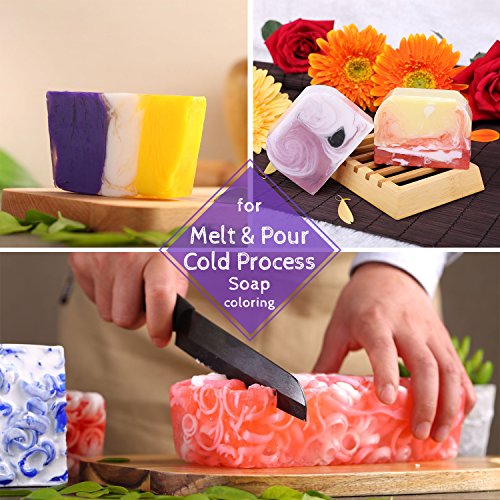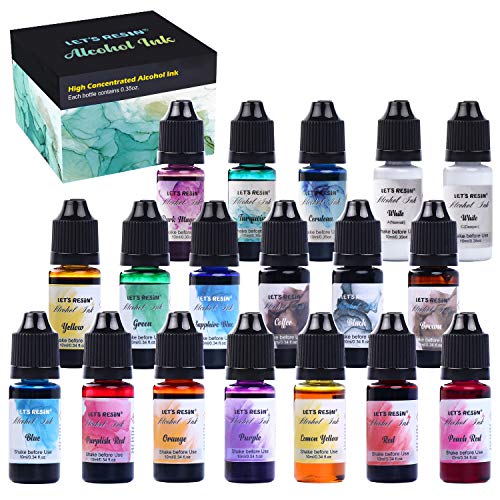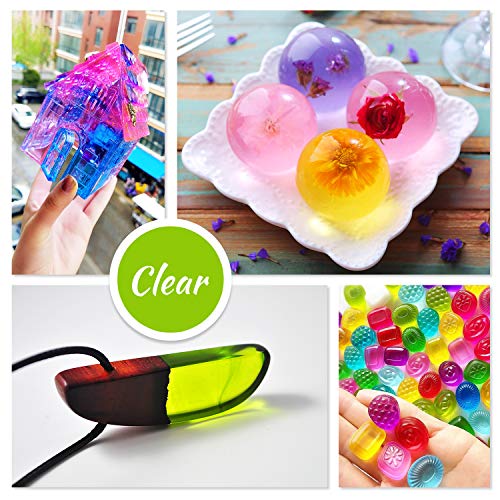When it comes to making resin art, the secret to achieving the best results lies in the products used Although there isn’t necessarily a secret formula, the basic supplies you’ll need to create resin art are: resin, and pigments. You’ll need a hardener too, but most resin retailers sell the resin and the hardener as a set, along with precise measurement instructions.
It’s important to follow the recommended resin:harder ratio as preparing your resin in the wrong ratio and using low-quality ingredients can significantly affect the outcome of your project.
Because there is a big difference between commercial resins and that used for arts and crafts, as well as the pigments used for resin, it’s very important to do some research before choosing the brand for each.
Note that there are a lot of great companies to choose from, both for resin and pigments. If you’re a soapmaker, you may even already have some of these pigments at home! As artists, it’s important to have a lot of variety of colorants, and pigments definitely give you more opportunities for custom colors.
Although it can be challenging to choose a specific brand to fit your needs, we’re here to help! In this article, we’ve narrowed down the top five best pigments for you to experiment with in your resin art.
Best Pigments for Resin Art: Brief Reviews
1. Variety Pack 1 by Black Diamond Pigments
Black Diamond Pigments is a very popular company within the resin community. You can tell because they have over 90,000 followers on Instagram alone! Black Diamond has a great reputation for quality and affordability, along with a great color catalogue.
As with most pigments, Black Diamond pigments can be used in cosmetics, resin art, for mixing with other art mediums and just about any other application where you have a liquid carrier.
Black Diamond carries variety packs in different color combos. At this time, there are about 20 different variety packs available. These range in price, but they are less than $20 on average, making it a great way to try them out without a huge commitment.
Product Highlights
Every color comes in a five-gram pack, which is measured by weight (not volume) to ensure an accurate and consistent amount.These inorganic pigments boast added stability in water and various solvents, including resin formulas.
While the product is made of high-quality and nontoxic pure mica powder, it is still highly recommended to wear a face mask when working with it to avoid inhalation. But, of course, if you’re working with resin, you’ve already got your PPE…right? This proviso includes gloves too. Although it’s pretty rare, sometimes people have an allergic reaction if pure mica comes in contact with their skin. Even if you don’t have an allergic reaction, mica can be pretty difficult to remove from the skin and clothes – so an apron, gloves, and safety glasses are a must..
We LOVE the Black Diamond Variety Pack One, which features gray, blue/green, Caribbean blue, cobalt blue, imperial red/pink, copper, mahogany, Tuscan sunset, vivid orange, and pure white. This is a great variety of bold colors to get you going.
The Good
If you are environmentally conscious, Black Diamond carries 100% vegan and cruelty free products. You’ll also find that each color is super pigmented, which means that a very small amount can go a very long way.
The Bad
Black Diamond Pigments are reasonably priced, but they aren’t the cheapest brand available. However, that shouldn’t deter you from purchasing from them – the quality is worth the price.
Pros:
- Variety packs available for experimenting
- Vegan and cruelty-free
- Made of high-quality pure mica powder
- Very pigmented
- Flexible as a coloring medium
Con:
- A bit expensive
2. 23-Color Mica Powder Set by DecorRom
Next in consideration is a set from a brand well-loved for its quality, pure mica powder colorants. You may recognize DecorRom as it’s available at quite a few different online marketplaces.
Like most pigments, you can use their colorants in resin art, soapmaking, and for making cosmetics too.
Product Highlights
DecorRom powder pigments are divided into two product lines: single-color 100-gram tubs and pigment powder sets of different quantities, including their 23-color set.
Other pigment powder sets are 21-color, 24-color, 28-color, and 50-color. This pack contains 23 10-gram packs in a very affordable price range. It comes in a wide spectrum of colors,ranging from warm bronzes and browns to cool black and blue.
In addition, you can also choose tubes containing colorants in cherry, chestnut, copper, forest, fuschia, gold, gray, kiwi, lavender, lemon, orange, pearl, pink, rose, teal, violet, and wine. These pigments are great for using solo, but if you want to broaden your color horizons, add them to your existing pigments and create your own colors!
DecorRom takes pride in its products’ easy-to-blend formula thanks to the high-quality mica powder used in making them.
Now, if all of this doesn’t convince you, this particular set also comes with a mini spoon for free, and who doesn’t love that?
The Good
We love that DecorRom’st is vegan, cruelty free, and easy to use. The color variety is also a big plus! DecorRom’s pigments are sent in resealable packages, so you don’t have to worry about accidentally spilling them all over yourself, your cat, and half your studio accidentally.
The Bad
We have seen some mixed reviews regarding the longevity of the colors; some artists have reported fading, so you may want to consider this if you’re using these pigments in a sellable piece.
Nevertheless, you will find many other options in the same price range.
Pros:
- Comes with 23 colors
- Vegan and cruelty-free
- Gentle on the skin
- Includes a free spoon
- Affordable
Con:
- Prone to fading
3. 24-Color Resin Colorant (Vibrant) by DecorRom
Not everyone enjoys working with powdered resin; every artist has different preferences, and sometimes powder is too unwieldy or difficult to mix.
Also, artists with respiratory issues (or those who live with someone who does) may find the small particles of powdered resin irritating to the lungs, requiring special breathing equipment, which isn’t ideal.
If you’re someone who has respiratory issues, or if you just don’t love powdered pigments, DecorRom offers a great set of liquid pigments as an alternative!
Aptly called Resin Colorant, this collection comes in four variants: 15-color, 18-color, 24-color (Crystal Clear), and this product, 24-color (Vibrant).
Product Highlights
This pack comes with 24 10ml bottles of liquid resin coloring. It is very affordable compared to similar options.The colors included are blue, black, caramel, cherry, clover, coffee, grape, green, jade, kiwi, lemon, lime, mango, navy, orange, peach, purple, red, rose, sky, tangerine, teal, violet, and white.
This is a really comprehensive set for artists who like to explore new color combinations and create their own shades. These pigments are easy to mix together, so there are hundreds of color combinations to create!
This set is specially formulated for UV resin projects. However, these pigments may also be used for other crafts like tumbler-making, garment dyeing, and coaster creation.
The Good
We love that DecorRom liquid pigments are non-toxic AND cruelty-free. Most of all, the vibrancy of the liquid pigments does NOT disappoint. If you’re looking for vibrant, bold colors, these should be on your shopping list.
The Bad
Although this is true of any liquid pigment, remember that using too much liquid pigment can extend your resin’s curing process. Always allow a bit more time for curing if you decide to use liquid pigments and follow the manufacturer’s instructions for usage amounts.
Pros:
- Comes with 24 colors
- Non-toxic and cruelty-free
- Produces bright and vibrant colors
- Budget-friendly
Con:
- Can make the setting process longer
4. Alcohol Ink Set by Let’s Resin
The Let’s Resin set is among the top choices when it comes to resin art pigments, especially in online marketplaces.
As the name suggests, Let’s Resin specializes in manufacturing resin-related art materials. It’s products include molds, resins, resin inclusions, stickers and other essential tools and supplies. An added bonus – they are very budget-friendly.
Let’s Resin’s line of coloring products alone includes more than a dozen different variants, including the set we’re reviewing below.
Product Highlights
Let’s Resin’s Alcohol Ink set comes with 18 10ml bottles of high-quality alcohol ink.
The colors included are black, blue, brown, coffee, dark magenta, green, lemon yellow, orange, and peach red. You will also get purple, purplish-red, red, sapphire blue, turquoise, yellow, cerulean, and two vials of white with varying brilliancy. You can either use these colors as they are or mix them to create a wider color palette for your projects.
While Let’s Resin’s pigments are formulated specifically for resin projects, you can use this set for other fluid art techniques, like traditional alcohol ink projects, tumbler-making, and even silk scarf dyeing.
If you use UV resin, this isn’t the product for you, however. Let’s Resin’s alcohol inks were specifically formulated for epoxy resin projects.
The Good
When you’re looking for resin products, it’s comforting to buy from a company who specializes in all things resin! We can definitely appreciate the huge selection of molds and supplies that Let’s Resin offers.
Don’t let the budget-friendly price trip you up; these are high quality alcohol inks. A single drop goes a long way, so make sure that you use it sparingly so you don’t compromise the integrity of your resin.
The Bad
If you use UV resin, this product simply isn’t the right choice. Other than that, we cnn’t find much fault in this product!
Pros:
- Comes with 18 colors
- Resin-focused brand
- Bright and vibrant formula
Con:
- Not good for UV Resin
5. 15-Color Resin Colorant by Limino
Although Limino isn’t a hugely popular brand as yet, we’ve been hearing great things from our artists about their products.
Currently, Limino has three resin coloring sets in the market: a 53-color mica powder pigment set, an 18-color resin dye set, and the 15-color resin colorant set.
Product Highlights
The 15-color set is specifically formulated for epoxy resin projects. It comes with 15 10 ml bottles in a variety of colors and at an affordable price.
From this set, you will get black, blue, blueberry, cherry, clover, kiwi, lavender, lemon, lime, mango, orange, peach, rose, snow, and violet. It might not have as many colors as the previous sets, but each one is highly pigmented and blendable.
While this set is formulated for resin use, you can also use this Limino set for other projects like tumblers and garments.
The Good
What we love best about this formula is the fact that it is easy to mix.
These inks can yield highly vibrant and uniform colors, so you can say goodbye to dark speckles and weird gradients.
The Bad
The only complaint we have about this set is that the white isn’t quite as vibrant as we expected.
Pros:
- Comes with 15 colors
- Non-toxic
- Bright and vibrant formula
- Affordable
Con:
- White pigment can be improved
Pigments for Resin Art: Buyer’s Guide
Already got a pigment set you want to try? Before you settle on one, make sure you consider the factors listed below first.
1. Formula
When you’re looking at pigments, you’ll want to check what the product is used for. Is it skin-safe? Nontoxic? Cruelty free? If it’s not readily apparent when you buy the product, don’t be afraid to reach out to the manufacturer and request details. Your safety and the safety of your customers is crucial!
Choosing a pigment that meets these criteria means you can focus on your creative process instead of worrying about accidental splatters coming in contact with your bare skin.
No matter how safe a product is, we ALWAYS recommend wearing the proper protective gear when working with resin. This includes gloves, a respirator, and glasses if available.
2. Vibrancy
Aside from the safety of the formula, also check its vibrancy. Will it produce the bright colors you need for your projects? How would one highly-saturated product in a smaller vial compare to another that gives more volume but not as much vibrancy?
Lastly, look into its finish. Will it produce a high-gloss effect, a metallic finish, or both? This is a very important factor, since different finishes can affect the final product quite a bit.
3. Translucency
Resin pigments come in a variety of translucencies and opacities. Remember to check the product’s label to ensure you’re getting a pigment that will match the effect you’re going for. Believe us, there is nothing more frustrating than messing up the mixing ratio while trying to add more drops of translucent colorant to make it more opaque.
This factor is also essential when working with UV resin, as opaque pigments can affect the setting effect of your UV light because it can’t pass through your work.
4. Blendability
It’s also important to look into the blendability of your pigments.While it’s always ideal to get a set with a wide gamut of colors, there will be times when you find yourself searching for a more specific hue or tone. Fortunately, you can always mix your own colors, provided you are using a highly-blendable formula.
These pigments are also less prone to color separation, weird specks, and unwanted gradients.
5. Other Features
Don’t forget to consider features that make it stand out from the rest, like the following:
Non-Fading
This feature will provide more longevity to your projects, especially those you expect to be more exposed to sunlight (such as bag tags and mobiles).This is also important to consider when working with UV resin that can significantly fade pigments from the get-go.
Fast-Drying
A lot of resin formulas take upwards of 24-78 hours to cure hours to cure. While it might prove okay when working on a single-pour project, this can be exceedingly unbearable if you’re planning a work that will require more layers.
That’s why having a colorant that can make this process quicker is definitely welcome in our studio.
Best Pigments for Resin Art FAQs
1. What supplies do I need for resin art?
This depends on the type of resin project you’re planning to make. At the very least, you need the resin liquid and its hardener solution, measuring cups, mixing sticks, colorants, and a pair of gloves. UV resin also requires a UV light to set the project.
Lastly, some artists prefer using a handheld torch or a heat gun to pop bubbles.
You will also need plastic wrap, tin foil, or another protectant for your work surface. Resin is extremely difficult to remove from wood, carpet, hair, or any other porous surface, so it’s important to protect everything around your work area to avoid ruining your surroundings!
2. What kind of dye do you use for epoxy resin?
We recommend using resin-specific pigments to add color to your resin projects, such as the ones featured above.
Nevertheless, feel free to experiment with other coloring mediums, such as acrylic paint, glass paint, and even airbrush paint. We do recommend avoiding things like oil paint, though, since this isn’t really compatible with resin.
3. How much pigment do you add to resin?
This depends on the formulation of your chosen product. Some produce really vibrant colors such that a couple of drops will already give the effect you need.
However, there are mediums that might require a few more drops to attain the brightness you’re going for.
Here’s a pro tip: add one drop of pigment to your resin at a time and mix it in well before adding another drop. It’s easier to add more color as you need than to dilute it.
If you’re not sure how much to use and you’re not comfortable winging it, reach out to the manufacturer and request the recommended usage rates; they should have this information readily available.
4. What can I use to color resin?
This section is the same as #2 and I recommend combining.
5. Can I mix acrylic paint with resin?
Yes. As mentioned, you can also use acrylic paint as a colorant for resin. We prefer using high-quality liquid acrylics because they blend better.
Don’t expect an ultra-glossy effect, though, since most acrylics produce a more subdued matte finish. Additionally, cheaper crafter acrylics may break down in resin. You’ll also want to be sure not to add too much paint, as this can cause your resin not to cure.
Final Verdict
Finding the right pigment or colorant for your resin project can be overwhelming! There are so many companies out there and more popping up all the time. You owe that selection to yourself, though; without so many artists interested in these techniques, we wouldn’t have the amazing selection of colors that we do now!
Although there are several important factors to consider when picking the best pigments for resin art, some good advice is not to overthink it. Pick a pigment set based on whether it’s compatible with your resin and whether you like the colors, and go from there!
Of the five sets we’ve featured here, DecorRom has a great price point and selection, so we’d recommend either set! Non-toxic and cruelty free, DecorRom checks all our boxes for quality, usability, and affordability.
We want to know: do you prefer powder, or liquid pigments? Why? Make sure to join our Facebook Group and let us know!










